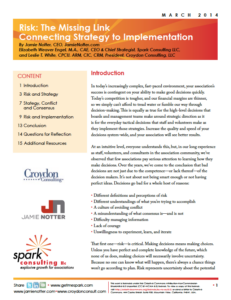 Does everyone in your organization understand risk in a similar way? Have you even talked about it? When you choose a strategy, have you considered the risks (and that includes the risk of foregoing opportunities, as well as the more obvious risks attached to your chosen course of action)? And do the people who are implementing your strategy ever consider risks?
Does everyone in your organization understand risk in a similar way? Have you even talked about it? When you choose a strategy, have you considered the risks (and that includes the risk of foregoing opportunities, as well as the more obvious risks attached to your chosen course of action)? And do the people who are implementing your strategy ever consider risks?
These are questions that my colleagues Elizabeth Engel and Leslie White and I grappled with in a White Paper that we just released, titled Risk: The Missing Link Connecting Strategy to Implementation (it’s free and the link takes you directly to the PDF). Leslie is a risk management consultant, and Elizabeth and I do a lot of work on strategy, so we’ve been playing around with the idea of how to help leadership teams work through some of these issues, and we decided to start with a White Paper that sets the stage.
And one of the key pieces for managing risk better is dealing with conflict. At the strategic level, this includes a more nuanced understanding of what it means to reach “consensus,” and at the implementation level, it simply means having your conflict conversations all the way, instead of the more common half-way approach. That means when it comes to running programs, your staff can actually weigh the risks and work through the silo-based disagreements so your strategy gets implemented. From the paper:
When your organization is ill-equipped to deal with conflict, the individual or department with the greatest internal clout tends to win. That usually means very little actually changes, since that same individual or department probably also had all the clout last year, too. The end result is that your critical strategic imperative goes nowhere.
The bottom line is that risk analysis is everyone’s job, but none of us will do that job well until we have some shared understanding of what risk even is. The sooner you start those conversations, the better.
